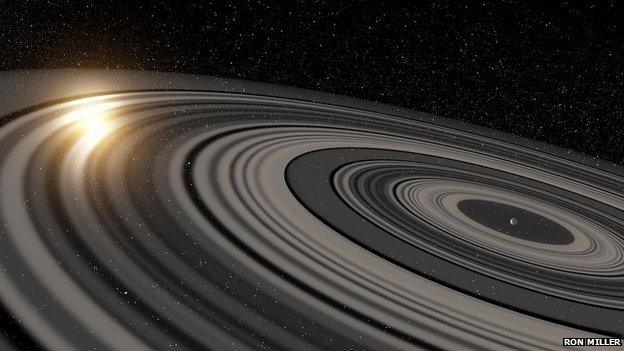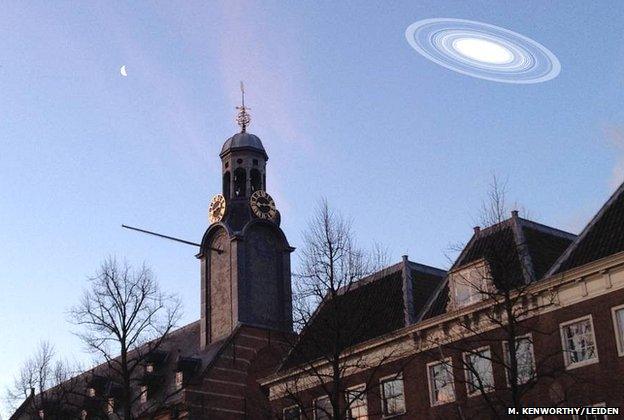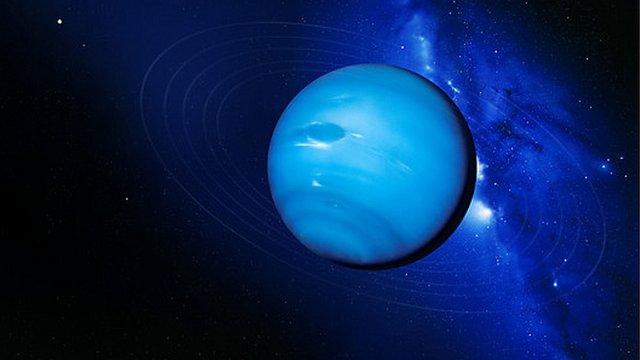Distant exoplanet hosts giant ring system
- Published

How the ring system might look up close
Astronomers say they have discovered a planet with a gigantic ring system that is 200 times larger than that around Saturn.
It is the first such structure detected around a planet beyond our Solar System.
The researchers say there are probably more than 30 rings, each measuring tens of millions of kilometres in diameter.
The findings by a Dutch-US team are to be published in the Astrophysical Journal, external.
Gaps detected in the ring system also suggest that some of the material may already have coalesced to form moons. This phenomenon can be seen at work in Saturn's rings today.
"You could think of it as kind of a super Saturn," said Prof Eric Mamajek, from the University of Rochester in the US.
The rings were found in data gathered by the SuperWASP observatory, which can detect exoplanets as they cross in front of their parent stars, causing the light from them to dim.
In this case, the astronomers saw a complex series of deep eclipses lasting for 56 days. They think this is caused by a planet with a giant ring system blocking out light as it passes in front of the star J1407.
"The light curve from end-to-end took about two months, but we could see very rapid changes in the space of one night," lead author Dr Matthew Kenworthy, from the University of Leiden, the Netherlands, told BBC News.
"Over a time of half an hour, the star can dim by 30 or 40%."
If Saturn's rings were the same size as those around J1407b, they would be easily visible from Earth at night and would be many times larger than a full Moon.

This artist's impression shows how the ring system might look in our night sky if they were put around Saturn
Other possibilities, such as a planet-forming disc (the swirling mass of dust and gas from which planets form around a star) can be ruled out. A disc, says Dr Kenworthy, would produce much smoother changes in the light curve of J1407.
Last year, the astronomers tried to find the planet itself, but were not able to observe it.
"We threw the kitchen sink at this, we tried every single technique that we could think of," said Dr Kenworthy.
"But the lack of a detection means it has to be substellar, and the only thing that could hold these rings in place is a planet."
The team thinks that the planet itself is most likely a gas giant like Jupiter, but between 10 and 40 times as massive as that planet.
The distant ringworld, named J1407b, might also offer a glimpse - on a much larger scale - of the process that led to the formation of moons around gas giants in our own Solar System.
"The planetary science community has theorised for decades that planets like Jupiter and Saturn would have had, at an early stage, disks around them that then led to the formation of satellites," said Prof Mamajek.
The astronomers found at least one clean gap in the ring structure.
"One obvious explanation is that a satellite formed and carved out this gap," said Dr Kenworthy. "The mass of the satellite could be between that of Earth and Mars."
The researchers are encouraging amateur astronomers to help monitor J1407, which would help detect the next eclipse of the rings. Observations of J1407 can be reported to the American Association of Variable Star Observers (AAVSO).
Follow Paul on Twitter, external.
- Published24 September 2014

- Published22 October 2013

- Published16 August 2013
